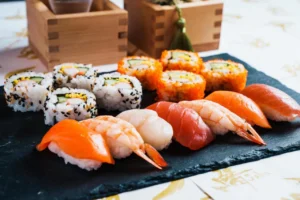The Art of Sushi: Crafting Japan’s Culinary Delight
The Art of Sushi. Sushi, now synonymous with Japanese cuisine, has a history that stretches back over a thousand years. Originally, sushi was a method of preserving fish in fermented rice, a practice that began in Southeast Asia and spread to Japan in the 8th century. This early form of sushi, known as “narezushi,” involved fermenting fish for several months to preserve it. By the Edo period (1603-1868), sushi evolved into “hayazushi,” where both rice and fish were eaten together, no longer requiring months of fermentation. This marked the beginning of sushi as we know it today, emphasizing fresh ingredients and quicker preparation methods.

The Different Types of Sushi
Sushi is not a single dish but rather a category that encompasses a variety of styles, each with its unique preparation method and ingredients. The most popular types include:
- Nigiri: A hand-pressed mound of rice topped with a slice of fresh fish or seafood, sometimes garnished with a dab of wasabi.
- Sashimi: Thinly sliced raw fish or seafood served without rice, often accompanied by soy sauce, wasabi, and pickled ginger.
- Maki: Sushi rolls made by layering rice and fillings on a sheet of seaweed (nori), then rolling it into a cylindrical shape and slicing it into bite-sized pieces.
- Temaki: Also known as hand rolls, these are cone-shaped rolls of nori filled with rice, fish, and vegetables, eaten by hand.
- Uramaki: A type of maki where the rice is on the outside of the roll, typically coated with sesame seeds or fish roe.
- Oshi: Pressed sushi made by layering ingredients in a mold and pressing them together, resulting in a compact, rectangular shape.
Each type of sushi has its own unique flavor profile and texture, showcasing the versatility and creativity of Japanese culinary art.
The Art of Sushi-Making: Precision and Skill
The craft of sushi-making is a revered art form that requires years of training and dedication. Sushi chefs, known as “itamae,” undergo rigorous apprenticeships to master the intricate skills needed to prepare sushi. This includes learning to handle a knife with precision, selecting the freshest ingredients, and understanding the delicate balance of flavors. The preparation of sushi rice, or “shari,” is a meticulous process that involves washing, cooking, and seasoning the rice with a mixture of vinegar, sugar, and salt. The rice must be at the right temperature and consistency to complement the fish and other ingredients perfectly. The art of sushi-making is not only about technical skill but also about an appreciation for simplicity, presentation, and the natural flavors of each ingredient.
Importance of Fresh Ingredients
The foundation of great sushi lies in the quality and freshness of its ingredients. In Japan, sushi chefs take great pride in sourcing the freshest fish and seafood from local markets, such as the famous Tsukiji and Toyosu markets in Tokyo. The seasonality of ingredients is also crucial, as certain fish are considered to be at their peak flavor during specific times of the year. Freshness is paramount, and many sushi restaurants display their catch of the day at the counter, allowing customers to choose their preferred fish. Additionally, rice, vegetables, and condiments like wasabi and soy sauce must be of the highest quality to complement the flavors and textures of the seafood. The emphasis on fresh, seasonal ingredients ensures that each piece of sushi delivers a pure and authentic taste experience.
Sushi Etiquette: A Delicate Dance
Enjoying sushi is not just about the taste; it’s also about the experience. There is a certain etiquette to follow when dining at a sushi restaurant, especially in Japan. Sushi should be eaten with your fingers or chopsticks, depending on your preference. It is considered polite to dip the fish side, rather than the rice, into soy sauce to avoid overpowering the delicate flavors. A small amount of wasabi can be added if desired, but many chefs season the sushi to perfection, so additional condiments are not necessary. Pickled ginger, or “gari,” is provided to cleanse the palate between bites. It is also customary to start with lighter-flavored fish like snapper and move to richer varieties like tuna or eel. Respecting these traditions enhances the dining experience and shows appreciation for the sushi chef’s craftsmanship.
Regional Sushi Specialties
While sushi has become a global phenomenon, regional specialties within Japan offer unique takes on this beloved dish. For example:
- Edomae Sushi: Originating from Tokyo (formerly Edo), this style focuses on fresh, raw fish and minimal seasoning to highlight natural flavors.
- Kansai Sushi: From the Osaka region, this style often incorporates vinegared rice mixed with various ingredients, creating a more flavorful base.
- Hokkaido Sushi: Known for its exceptionally fresh seafood due to the region’s proximity to abundant fishing grounds, Hokkaido sushi often features sea urchin, salmon roe, and crab.
- Kyushu Sushi: Kyushu’s sushi often incorporates unique ingredients like seared fish, sweet soy sauce, and special vinegars, giving it a distinctive taste.
Each region in Japan has its own sushi style, reflecting local tastes, ingredients, and culinary traditions.
The Global Rise of Sushi
Sushi has transcended its Japanese roots to become a global culinary sensation. From high-end restaurants in New York and London to casual sushi bars in Sydney and São Paulo, sushi has captured the imagination of food lovers worldwide. Its rise in popularity can be attributed to its versatility, health benefits, and the appeal of Japanese cuisine’s aesthetic and meticulous preparation methods. Today, sushi is enjoyed in various forms, from traditional nigiri and sashimi to creative fusion rolls that incorporate ingredients like avocado, cream cheese, and even truffle oil. While these modern interpretations have expanded sushi’s global reach, traditional sushi remains highly respected and sought after by purists and connoisseurs.
The Role of Sushi in Japanese Culture
In Japan, sushi is more than just a dish; it is a cultural symbol that embodies the nation’s values of precision, harmony, and respect for nature. The preparation and presentation of sushi reflect the Japanese aesthetic of “wabi-sabi,” finding beauty in simplicity and imperfection. Sushi is also a communal food that brings people together, whether at a casual conveyor belt sushi bar or an exclusive “omakase” dining experience where the chef creates a personalized menu for each guest. Sushi chefs, with their dedication to their craft, are often seen as artists, and their work is a form of cultural expression. The art of sushi-making and the experience of enjoying sushi are deeply interwoven with Japanese culture and heritage.
Conclusion
The art of sushi is a testament to Japan’s rich culinary heritage and its emphasis on precision, quality, and simplicity. From its humble beginnings as a method of preserving fish to its status as a global culinary delight, sushi has evolved while retaining its core principles of craftsmanship and respect for ingredients. Whether enjoyed in its traditional form or through modern interpretations, sushi continues to captivate food lovers around the world with its delicate balance of flavors, textures, and artistry. As sushi continues to evolve, its significance in both Japanese culture and global cuisine remains unwavering, celebrating the timeless appeal of this beloved culinary art.



